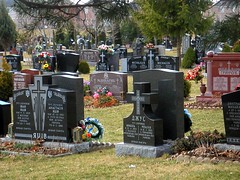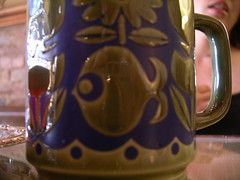Real Estate for the Dead
Please note: This post is not meant to criticize or offend anyone who has experienced a death of friend of family and has had to make these decisions. It’s only intent is to bring attention to a practice that seems to me to go unquestioned, when there may be other, viable alternatives worthy of consideration.
There is an increasing trend for places to be owned, to be attached to names, to be logo-fied. At the university of Windsor we don’t just have a student centre, we have the “CAW Student Centre”. The buildings include the Toldo Building, The Jackman Centre for Dramatic Arts, Chrysler Tower, Chrysler Halls North & South — these are the names of local funders, who’ve made donations to the university. In the community, parks and greenspaces follow the trend too. People own property and build fences to keep others out. It carries on throughout life, until the ultimate in real estate ownership: a graveyard plot and tombstone, yours forever.
I’ve been telling people around me for years that I want to be cremated when I die and I’ve recently realized I don’t want to be responsible for using up even more land after I die. I don’t want to be tied (figuratively since I’ll be ashes) or have my memory tied to a single geographic location. When I’m done with my body, burn it up so it’s certain I’m dead (irrational fear of premature burial, thank you Edgar Allen Poe) and use me as compost to plant something — or else sprinkle me in a favourite place. I’m planning on living a good many more years so I’m not quite sure where that favourite place is yet.
I definitely know I don’t want any deadland. I feel no draw to the cemeteries where my grandparents are buried. I do feel drawn to the houses where they lived and where I visited them, to the things of theirs that I use in my home or have hanging on my walls or sitting on my shelves — these are the places and things that remind me of them. When I’m telling my children stories about them and their lives we look at these treasures. There is nothing for me at the cemetery.
I do wonder at the amount of money that people spend on tombstones and plots and upkeep (not to mention caskets) and I wonder how it came to be that this is now the standard in our society — that people have accepted this as “what must be done” when someone dies. I wonder what those spaces would look like without the markers — if every marker were instead a tree would we still have air quality problems here? Is it that people fear being forgotten? That without the stone there is nothing to remind the living that they even existed? Or is it the living that want the stone and land? To make the act of remembering a physical exercise (go to the cemetery) instead of an emotional/intellectual one (talk about the dead, think about them, etc)? or is it something I just don’t understand?
I’d rather invest in my family and community now, and leave the space for the living — not because I have a need to be remembered, but because I can’t rationalize consuming resources after I’m dead. I just won’t be needing them.
 Comments(0)
Comments(0)


